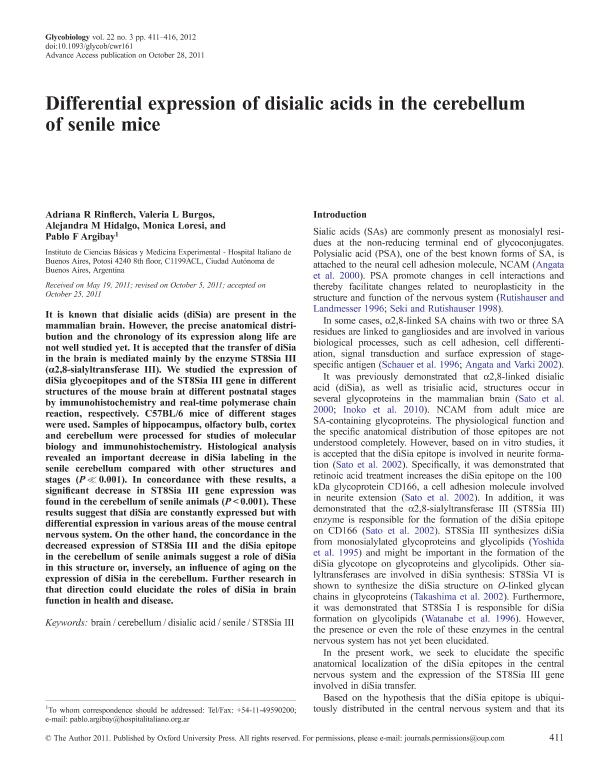Mostrar el registro sencillo del ítem
dc.contributor.author
Rinflerch, Adriana Raquel

dc.contributor.author
Burgos, Valeria Laura

dc.contributor.author
Hidalgo, Alejandra Mabel

dc.contributor.author
Loresi, Monica Alejandra

dc.contributor.author
Argibay, Pablo F.
dc.date.available
2023-04-20T13:36:01Z
dc.date.issued
2012-03
dc.identifier.citation
Rinflerch, Adriana Raquel; Burgos, Valeria Laura; Hidalgo, Alejandra Mabel; Loresi, Monica Alejandra; Argibay, Pablo F.; Differential expression of disialic acids in the cerebellum of senile mice; Oxford Univ Press Inc; Glycobiology; 22; 3; 3-2012; 411-416
dc.identifier.issn
0959-6658
dc.identifier.uri
http://hdl.handle.net/11336/194718
dc.description.abstract
It is known that disialic acids (diSia) are present in the mammalian brain. However, the precise anatomical distribution and the chronology of its expression along life are not well studied yet. It is accepted that the transfer of diSia in the brain is mediated mainly by the enzyme ST8Sia III (α2,8-sialyltransferase III). We studied the expression of diSia glycoepitopes and of the ST8Sia III gene in different structures of the mouse brain at different postnatal stages by immunohistochemistry and real-time polymerase chain reaction, respectively. C57BL/6 mice of different stages were used. Samples of hippocampus, olfactory bulb, cortex and cerebellum were processed for studies of molecular biology and immunohistochemistry. Histological analysis revealed an important decrease in diSia labeling in the senile cerebellum compared with other structures and stages (P ≪ 0.001). In concordance with these results, a significant decrease in ST8Sia III gene expression was found in the cerebellum of senile animals (P < 0.001). These results suggest that diSia are constantly expressed but with differential expression in various areas of the mouse central nervous system. On the other hand, the concordance in the decreased expression of ST8Sia III and the diSia epitope in the cerebellum of senile animals suggest a role of diSia in this structure or, inversely, an influence of aging on the expression of diSia in the cerebellum. Further research in that direction could elucidate the roles of diSia in brain function in health and disease.
dc.format
application/pdf
dc.language.iso
eng
dc.publisher
Oxford Univ Press Inc

dc.rights
info:eu-repo/semantics/openAccess
dc.rights.uri
https://creativecommons.org/licenses/by-nc-sa/2.5/ar/
dc.subject
BRAIN
dc.subject
CEREBELLUM
dc.subject
DISIALIC ACID
dc.subject
SENILE
dc.subject
ST8SIA III
dc.subject.classification
Otras Medicina Básica

dc.subject.classification
Medicina Básica

dc.subject.classification
CIENCIAS MÉDICAS Y DE LA SALUD

dc.title
Differential expression of disialic acids in the cerebellum of senile mice
dc.type
info:eu-repo/semantics/article
dc.type
info:ar-repo/semantics/artículo
dc.type
info:eu-repo/semantics/publishedVersion
dc.date.updated
2023-04-20T12:30:02Z
dc.journal.volume
22
dc.journal.number
3
dc.journal.pagination
411-416
dc.journal.pais
Reino Unido

dc.description.fil
Fil: Rinflerch, Adriana Raquel. Hospital Italiano; Argentina. Consejo Nacional de Investigaciones Científicas y Técnicas; Argentina
dc.description.fil
Fil: Burgos, Valeria Laura. Hospital Italiano; Argentina. Consejo Nacional de Investigaciones Científicas y Técnicas; Argentina
dc.description.fil
Fil: Hidalgo, Alejandra Mabel. Hospital Italiano; Argentina
dc.description.fil
Fil: Loresi, Monica Alejandra. Hospital Italiano; Argentina. Consejo Nacional de Investigaciones Científicas y Técnicas; Argentina
dc.description.fil
Fil: Argibay, Pablo F.. Hospital Italiano; Argentina
dc.journal.title
Glycobiology

dc.relation.alternativeid
info:eu-repo/semantics/altIdentifier/url/https://academic.oup.com/glycob/article/22/3/411/2005013
dc.relation.alternativeid
info:eu-repo/semantics/altIdentifier/doi/http://dx.doi.org/110.1093/glycob/cwr161
Archivos asociados
